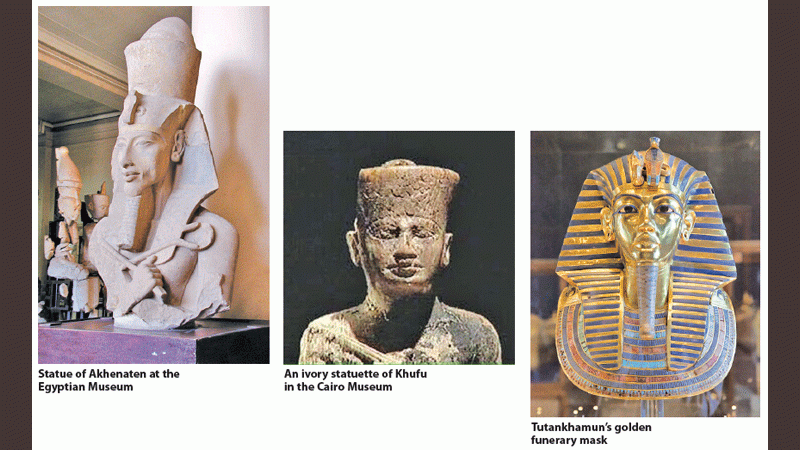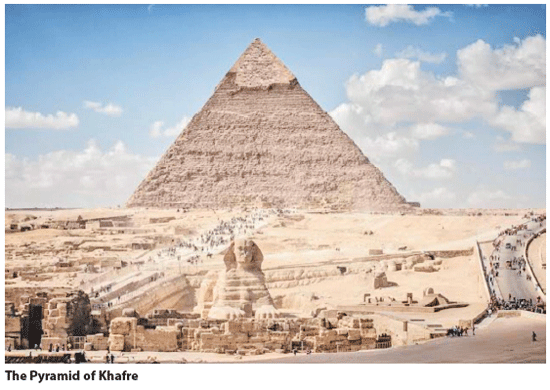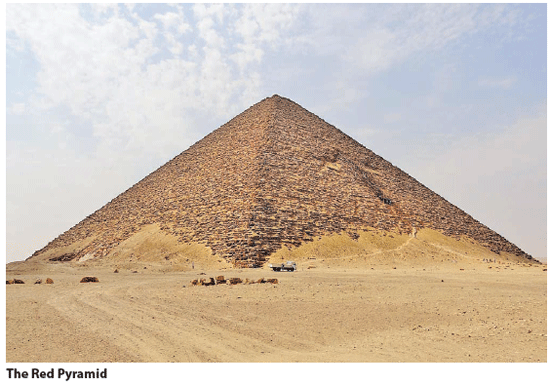
What makes a kingdom, or in this case an empire, mighty? It is the actions of its leaders and its architectural monuments. They give us a glimpse of the golden eras of early rulers. One such example is ancient Egypt, whose pharaohs initiated the construction of hundreds of pyramids. Those still standing today, show the durability and technological expertise of Egyptian engineers.
Some pharaohs
Akhenaten (1353-1336 BC or 1351-1334 BC - disputed)
Akhenaten or as he was previously known, Amenhotep the Fourth made a mark in Egyptian history by abandoning the Egyptian tradition of worshipping multiple gods, called polytheism, and embracing the worship of Aten, an aspect of the sun deity Ra.
When some dozen years later, rulers without clear rights of succession from the Eighteenth Dynasty founded a new dynasty, they discredited Akhenaten and his immediate successors and referred to Akhenaten as the enemy or that criminal in archival records.
He has been described not only as the greatest idealist of the world but also as a heretic a fanatic and as possibly insane or mad.
Khufu (2589-2566 BC)
 Khufu is celebrated for the erection of the Great Pyramid of Giza (one of the Seven Wonders of the Ancient World), during his rule from 2589 to 2566 BC. Khufu’s life is presented by various authors and historians in a contrasting way; even though the king enjoyed a long-lasting cultural heritage preservation during the periods of both the Old Kingdom as well as the New Kingdom. Some historians including Manetho, Diodorus and Herodotus give a very negative depiction of Khufu’s character.
Khufu is celebrated for the erection of the Great Pyramid of Giza (one of the Seven Wonders of the Ancient World), during his rule from 2589 to 2566 BC. Khufu’s life is presented by various authors and historians in a contrasting way; even though the king enjoyed a long-lasting cultural heritage preservation during the periods of both the Old Kingdom as well as the New Kingdom. Some historians including Manetho, Diodorus and Herodotus give a very negative depiction of Khufu’s character.
Historians estimate that the Pharaoh Khufu died around the year 2566 BC, but the causes are unknown to date. After his death, Khufu was entombed in the Great Pyramid of King Khufu, at the Giza complex.
The idea that Khufu used slaves to build the pyramid comes from Greek historian Herodotus, who described Khufu as a cruel and wicked leader.
But the Westcar Papyrus describes Khufu as a traditional oriental monarch: good-natured, amiable to his subjects and interested in the nature of human existence and magic.
Tutankhamun
(1332-1323 BC)
Tutankhamun, most commonly known as King Tut, reached popularity after his tomb was discovered in 1922 by renowned archaeologist Howard Carter.
He ascended the Egyptian throne at either eight or nine years , making him the youngest-ever pharaoh to rule over Ancient Egypt.
His tomb is the only royal burial site found intact within the past few centuries.
Ramses II (1279-1213 BC)
The greatest pharaoh of the New Kingdom, itself the most powerful period of Ancient Egypt, Ramses the Second is known as Ramses the Great to honour his military expeditions.
After assuming the throne at the age of 24, he ruled for over 60 years until his death in 1213 BC, aged 90 or 91.
 Ramses is renowned for his battle campaigns in the nations of Syria, Nubia (part of present-day Egypt and Sudan) and Libya.
Ramses is renowned for his battle campaigns in the nations of Syria, Nubia (part of present-day Egypt and Sudan) and Libya.
Ramses II had reigned for over 66 years, at the time of his death.
He outlived many of his children (numbering over one hundred) and most of his consorts as well.
The Great Pyramid of Giza
The Pyramid of Khufu, or Cheops, is the oldest and largest pyramid in the Giza pyramid complex of Greater Cairo, as well as the largest in Egypt.
It is the oldest of the Seven Wonders of the Ancient World, and the only one to remain largely intact.
It was the tallest man-made structure in the world for over 3,800 years, after its completion in the 26th Century BC.
The Great Pyramid was built by quarrying an estimated 2.3 million large blocks weighing 6 million tonnes.
The Pyramid of Khafre
This pyramid is also part of the Giza pyramid complex, second in height and size only to the Great Pyramid. It is said that this pyramid was built under the command of Pharaoh Khafre, who was the son of Khufu and father of Menkaure, to whom the other two pyramids of the same funerary complex were dedicated.
Each Egyptian pyramid is interesting in its own way, but the tomb of Khafre immediately catches the eye of tourists thanks to the remnants of the cladding at the top, its central position, and the fact that it seems to be the tallest of all.
The Pyramid of Djoser (the Step Pyramid of Saqqara)
The Pyramid of Djoser, completed in the 27th century BC, is the oldest pyramid, and one of the most popular in Egypt.
It started as a mastaba tomb — a flat-roofed structure with sloping sides — and, through a series of expansions, evolved into a 197- foot-high (60 metres) pyramid, with six layers, one built on top of the other.
The pyramid was constructed using 11.6 million cubic feet (330,400 cubic metres) of stone and clay.
The tunnels beneath the pyramid form a labyrinth about 3.5 miles (5.5 kilometres) long.
The pyramid is at the centre of a complex 37 acres (15 hectares) in size.
This complex is surrounded by a recessed limestone wall that contains 13 fake doorways as well as the real colonnaded entrance on the southeast side.
The Red Pyramid (North Pyramid)
The Red Pyramid, also called the North Pyramid, is the largest of the pyramids at the Dahshur necropolis in Cairo,Egypt.
It is the third-largest pyramid in all of Egypt, surpassed by only the great pyramids of Khufu and Khafre.
The Red Pyramid is 105 metres (344 ft) high, and 220 metres (720 ft) wide.
The Red Pyramid, along with the Bent Pyramid, was closed to tourists for many years because of a nearby army camp.
It is now usually open for tourists and a somewhat intrusive ventilation has been installed which pipes air down the entrance shaft to the interior chambers. Visitors climb steps cut in or built over the stones of the pyramid to an entrance high on the north side.
